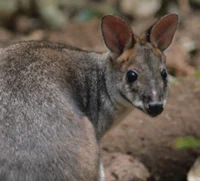The red-legged pademelons seen foraging on the forest floor at Mary Cairncross are small macropods (the same family of marsupials as kangaroos), named for their large hind-legs and feet.
Standing only 40 - 55cm at full height, these little mammals are shy and well camouflaged. Thick grey-brown fur covers their head and back. Their cream-white underbelly is accentuated by rust colouration on their limbs, cheeks and tail.
Red-legged pademelons are active most of the morning and day, resting in the afternoon. Their diet is varied, consisting of fungi, fruit, leaves, grasses, tree bark and some insects. During the day you may see them foraging with their heads drooped and tails between their legs. They forage in small pods in the thicker understory growth, where they find refuge in numbers. If the pademelon feels threatened they will thump the ground with their hind feet to warn the others. This is a sign your presence is unwanted.
Mostly silent creatures, occasionally you may hear a harsh rasping noise that the male pademelon makes during courtship, or the soft cooing of a mother to her young.
Like most macropods and some other marsupials, the red-legged pademelon has an embryonic diapause reproductive system. Approximately 3 – 6 weeks after mating, the females will give birth to a single live young. Soon after giving birth, the mother is capable of conceiving again. Until the young joey stops suckling the development of the next baby will remain suspended. This system allows the mother to nurture three dependants at the same time: a youngster by her side, a joey in her pouch and the stalled embryo in her womb. Remarkably, she is able to produce different types of milk depending on the developmental stage of her young.
Land-clearing has lead to extensive loss of habitat for this species. Being a ground-dwelling marsupial, red-legged pademelons they are vulnerable to predators such as dogs. The small population residing in our reserve is confined within the limits of the forest, where domestic pets are not permitted and feral threats are managed.
Ongoing population research in partnership with the University of the Sunshine Coast is enabling reserve managers to monitor the red-legged pademelons that live at Mary Cairncross.
Help contribute to our understanding of pademelon numbers in the reserve by joining a seasonal pademelon survey.

